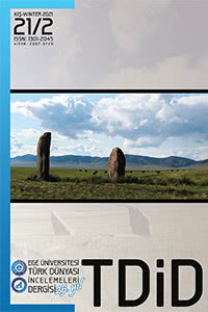Grice’in Niyet-Merkezli Semantik Bakış Açısı Bağlamında Duha Koca Oğlu Deli Dumrul Hikâyesinin İncelenmesi
H. Paul Grice tarafından öne sürülen niyet-merkezli semantik bakış açışına göre karşılıklı konuşmanın veya iletişimin başarılı sayılabilmesi cümlelerin mantıksal kurallar çerçevesinde düzenlenmesine bağlıdır. Bireyler arasındaki iletişimi “doğal anlamlı” (istemsiz veya irade dışı gerçekleşen anlam) ve “doğal-olmayan anlamlı” (istemli veya özgür iradeli gerçekleşen anlam) olmak üzere ikiye ayıran Grice konuşmacı tarafından söylenen her cümlenin iletişimsel bağlamda bir işleve sahip olduğunu belirtir. Dolayısıyla insanların birbirlerini anlamaları karşılıklı söylediklerinden ziyade demek istedikleri şeylere bağlıdır. Grice “işbirlikçi ilkeler ve iletişimin kuralları” adı altında öne sürdüğü işbirliği ilkesine göre konuşma kuralını dörde ayırır: Konuşmacının mümkün olduğu kadar bilgilendirici olduğu nicelik kuralı (maxim of quantity); dürüstçe, doğru bilgiler vermeye çalıştığı nitelik kuralı (maxim of quality); konuşulan konu ile ilgili şeyler söylediği bağıntı kuralı (maxim of relation); mümkün olduğunca açık ve net olduğu açıklık kuralıdır (maxim of manner). Bu çalışmada Oğuz Türklerinin bilinen en eski epik hikâyelerden biri olan ve Oğuzların iletişim kültürüne ait semantik veriler sunan Dede Korkut Kitabı’ndaki Duha Koca Oğlu Deli Dumrul Hikâyesi Grice’in niyet-merkezli semantik bakış açısı bağlamında işbirlikçi ilkeler ve iletişimin kuralları göz önünde bulundurularak çözümlenecektir. Çalışmanın sonucunda konuşmacıların nicelik, nitelik, bağıntı ve açıklık kavramlarına ne derece bağlı kaldıkları ortaya çıkarılacak ve Oğuzların iletişim özellikleri hakkında bir sonuca varılacaktır.
Anahtar Kelimeler:
Duha Koca oğlu Deli Dumrul hikâyesi, Paul Grice, semantik, karşılıklı konuşma, dil
An Analysis of the Story of Wild Dumrul Son of Dukha Koja through the Grician Lenses of Intention-Based Semantic
According to H. Paul Grice’s intention-based semantics, the sentences are requiredAccording to H. Paul Grice’s intention-based semantics, the sentences are requiredAccording to H. Paul Grice’s intention-based semantics, the sentences are requiredto have been structured within rational principles in order to assume the converto have been structured within rational principles in order to assume the converto have been structured within rational principles in order to assume the conversation or communication stimulating. By classifying the conversation among thesation or communication stimulating. By classifying the conversation among thesation or communication stimulating. By classifying the conversation among theindividuals into two such as the “natural meaning” and the “non-natural meaning”,individuals into two such as the “natural meaning” and the “non-natural meaning”,individuals into two such as the “natural meaning” and the “non-natural meaning”,Grice, indeed, identifies that every sentence uttered by an utterer is functional inGrice, indeed, identifies that every sentence uttered by an utterer is functional inGrice, indeed, identifies that every sentence uttered by an utterer is functional ina communicative context. Accordingly, individuals’ understanding one another proa communicative context. Accordingly, individuals’ understanding one another proa communicative context. Accordingly, individuals’ understanding one another profoundly depends upon the things that they want to say rather than the thingsfoundly depends upon the things that they want to say rather than the thingsfoundly depends upon the things that they want to say rather than the thingsthat they say. Thus, Grice proposed the general principles under the title of “cooperative principle and the maxims of conversation”, a norm governing all cooperative interactions among humans such as: “Maxim of quantity”, where the utterer’s contribution is as informative as is required; “maxim of quality”, where theutterer attempts at making his/her contribution one that is true; “maxim of relation”, where the utterer’s contribution focuses on relevance to the conversation;and lastly, “maxim of manner”, where the utterer contributes by avoiding obscureexpressions. In this study, the Story of Wild Dumrul Son of Dukha Koja in TheBook of Dede Korkut, one of the most ancient epic stories of the Oghuz Turksand a narration which presents semantic data on the communicative cultural aspects of the Oghuz, will be analysed through Grice’s intention-based semantics byconsidering “cooperative principle and the maxims of conversation”. The result ofthe study reveals that to what extend the utterers will be loyal to the cooperativeprinciples such as maxim of quantity, quality, relation and manner and the studywill also uncover the communicative characteristics of the Oghuz Turks
Keywords:
The story of Wild Dumrul son of Dukha Koja, Paul Grice, semantics, conversation, language,
- ISSN: 1301-2045
- Başlangıç: 1996
- Yayıncı: Ege Üniversitesi Türk Dünyası Araştırmaları Enstitüsü
Sayıdaki Diğer Makaleler
Yrd. Doç. Dr. Mustafa GÜLTEKİN
İmge ve Göstergeler Uzamı: Dede Korkut Hikâyeleri
Dede Korkut’ta Yer Alan Atasözlerinde Metaforların İşleyişi
Kuru Göz Tedavisinde Dede Korkut Mucizesi
Prof. Dr. Sait EĞRİLMEZ, Prof. Dr. Metin EKİCİ, Doç. Dr. Oğuz GÖZEN
Uygulamalı Halk Bilimi Açısından Eğitim Sürecinde Dede Korkut
Dede Korkut Kitabı’nda Tipik Bir İstinsah Hatası Üzerine
